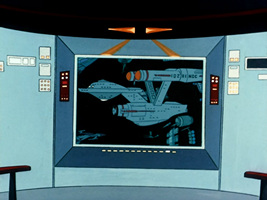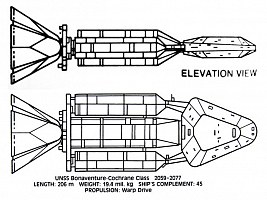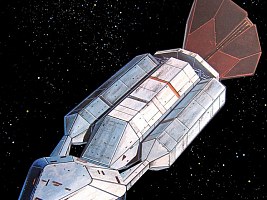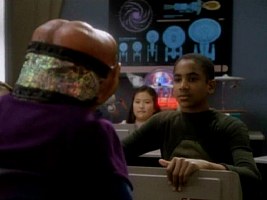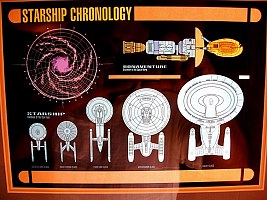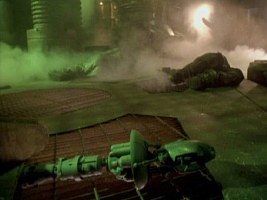From the Bonaventure to the Phoenix
Ever-changing ideas of the first warp ship - by Jörg Hillebrand and Bernd Schneider
The history of the first warp vessel, whether it was built by Zefram Cochrane himself or not, was subject to a number of revisions throughout the history of the Star Trek production. Ships with different names and different designs were labeled as the "first warp-powered vessel" or something along these lines. They are listed and investigated in the following.
Analysis
The Cage
In the first pilot episode, after the survivors from the SS Columbia have been found on Talos IV, Tyler tells them that "the time barrier's been broken". We could understand this as a reference to the invention of warp drive. It would have taken place no more than 18 years before the episode, the time when the Columbia crashed on the planet (although it raises the question how the Columbia could have got there without FTL propulsion). Considering that there is solid evidence from later episodes that warp drive already existed for many decades prior to TOS, we could still argue that the "broken time barrier" refers to a breakthrough in warp propulsion not unlike the first warp flight. A breakthrough so significant that some people in the 23rd century casually call it the "invention of warp drive".
TOS: Metamorphosis
This TOS episode does not show or mention a first warp ship, but it introduces us to the inventor of warp propulsion, Zefram Cochrane. Nothing is mentioned that would imply that Cochrane himself built the first warp ship, however. We may only surmise that the first warp flight took place not too long after Cochrane's revolutionary discovery irrespective of his possible direct involvement in the building of the prototype. Since Cochrane is said to have disappeared at the age of 87 some 150 years prior to "Metamorphosis", the latest date for the launch of the first warp vessel is around 2117, because realistically he could have made his final journey into outer space only on a warp-powered ship. Since the Valiant quite obviously went to warp as soon as around 2065 according to TOS: "Where No Man Has Gone Before", the first warp prototype must have been launched a few years earlier, when Cochrane was still a young man.
Side note It is an already classic inconsistency that, according to Kirk, Cochrane used to be a denizen of the Alpha Centauri in the TOS episode, whereas "First Contact" leaves no doubt that he had never left Earth until he went of the first warp flight. Read more at Biography Inconsistencies.
TAS: The Time Trap
 The Enterprise crew rediscovers the long-missing Bonaventure
inside a space anomaly in the Delta Triangle in TAS: "The Time Trap". No date is mentioned as to when the ship was lost. But Scotty states that the Bonaventure was "the first ship to have warp drive installed". This is clearly contradicted at latest in "Star Trek: First Contact". In view of the typical Starfleet look of the Bonaventure (the design is just a distorted Constitution class in essence) the idea is dubious even at the time of the TAS episode, because how could an interstellar Federation be formed in the first place without warp drive?
The Enterprise crew rediscovers the long-missing Bonaventure
inside a space anomaly in the Delta Triangle in TAS: "The Time Trap". No date is mentioned as to when the ship was lost. But Scotty states that the Bonaventure was "the first ship to have warp drive installed". This is clearly contradicted at latest in "Star Trek: First Contact". In view of the typical Starfleet look of the Bonaventure (the design is just a distorted Constitution class in essence) the idea is dubious even at the time of the TAS episode, because how could an interstellar Federation be formed in the first place without warp drive?
Regarding the age of the Bonaventure, Spock speculates that "the crew's descendants may still be living", thereby implying that at least roughly a century has passed since her disappearance. This rules out the Bonaventure as the ship that broke the "time barrier" that was referred to in "The Cage". However, the Bonaventure could be old enough to be Cochrane's warp ship prototype, although most other evidence speaks against it.
TAS: The Counter-Clock Incident
 Starfleet veteran Sarah April says she was
"the first medical officer aboard a ship equipped with warp drive"
in TAS: "The Counter-Clock Incident". While this is not exactly the same as "the medical officer on the first ship with warp drive", it still tells us that her service must have been soon after the launch of the Bonaventure, and possibly on the Bonaventure herself, luckily ending before the vessel's disappearance. It is just too obvious that a big ship like the Bonaventure would be in need of a medical officer just like any vessel of the NX-01 era too. So rather than being mistaken about the nature of warp drive like Scotty (which in her case would be rather forgivable), Sarah April may exaggerate a great deal. It is still possible that Sarah April served on the nameless ship that broke the "time barrier" as mentioned in "The Cage".
Starfleet veteran Sarah April says she was
"the first medical officer aboard a ship equipped with warp drive"
in TAS: "The Counter-Clock Incident". While this is not exactly the same as "the medical officer on the first ship with warp drive", it still tells us that her service must have been soon after the launch of the Bonaventure, and possibly on the Bonaventure herself, luckily ending before the vessel's disappearance. It is just too obvious that a big ship like the Bonaventure would be in need of a medical officer just like any vessel of the NX-01 era too. So rather than being mistaken about the nature of warp drive like Scotty (which in her case would be rather forgivable), Sarah April may exaggerate a great deal. It is still possible that Sarah April served on the nameless ship that broke the "time barrier" as mentioned in "The Cage".
Or does she just mean she was the "first (=chief) medical officer" on no particularly important warp ship, which would pose no problem at all? This doesn't seem so, as she puts too much emphasis on "first", and Kirk agrees with her that she used to be a pioneer in space.
Spaceflight Chronology
This book from 1980 is non-canon and was never really intended to be canon, also because it consists of just too much speculation. Aside from Rick Sternbach's co-authorship (he made the illustrations) there is one reason, however, to take the Spaceflight Chronology into account. It is the first time that the name "Bonaventure" (as a homage to TAS: "The Time Trap"), or any ship name at all, is linked to Zefram Cochrane (as a homage to TOS: "Metamorphosis"). The design depicted in the book will never show up in any canon installment of Star Trek though.
We learn in the Spaceflight Chronology that the Bonaventure was "the first ship with warp drive" and was launched in 2061. Actually, according to the book, an Earth sublight ship named UNSS Icarus made first contact with Alpha Centauri in 2048 where Zefram Cochrane, a native of the planet, discovered the principle of warp drive in 2051 (at the age of 21!). The Bonaventure is listed as a ship of the Cochrane class, which is odd, because in the tradition of Earth and Starfleet we would expect the class to be named after its lead ship, not after the inventor of its propulsion technology. There is no mention of Cochrane being involved in the development of the class aside from being its name giver.
Rick Sternbach: "I wish I had more information or memories about this particular ship, but there's not much to tell. The design was part of an evolution of early warp ships, with the lineage ultimately taking the reader up to the TOS Enterprise and the refit. The beginnings of the familiar ship elements are there, just not terribly obvious. The forward section evolved from an aerodynamic body and would later become the saucer, the body behind it would evolve into the secondary hull, and the side pods would become the warp nacelles. The big package at the aft end housed big waste heat radiators and was probably where the impulse nozzles would be located.
Of course, the Phoenix seen in 'First Contact' went straight to the TOS-type nacelles, so that short-circuited any slower developmental hardware steps."
Star Trek Chronology (1st & 2nd edition)
 The first Star Trek Chronology appeared in 1993 as an officially approved timeline of the Star Trek Universe with a comparably small amount of speculation. The date of the first warp flight is 2061 just as in the earlier Spaceflight Chronology. The first warp vessel is unnamed here, and the design is dissimilar from any of the two Bonaventures. Cochrane is now from Earth and moved to Alpha Centauri later. It is stated that he himself was involved in the building of the first warp vessel.
The first Star Trek Chronology appeared in 1993 as an officially approved timeline of the Star Trek Universe with a comparably small amount of speculation. The date of the first warp flight is 2061 just as in the earlier Spaceflight Chronology. The first warp vessel is unnamed here, and the design is dissimilar from any of the two Bonaventures. Cochrane is now from Earth and moved to Alpha Centauri later. It is stated that he himself was involved in the building of the first warp vessel.
The first edition of the Star Trek Chronology from 1993 depicts two black-and-white photos of a miniature and a color painting of Zefram Cochrane's unnamed first warp vessel. The painting can be found on the front cover. The first photo is a three-quarter front view, which adorns the introduction to the 21st century chapter with the heading "Breaking the warp barrier". The second photo shows a side/rear view of the vessel in the entry to the year 2061, when the first warp flight was intended to have taken place. It is labeled "Zefram Cochrane's first warp-powered spacecraft".
We can make out a registry on the painting and even a bit clearer on the front view photo. It appears to be "C1-21", which does not make sense compared to other Star Trek registries, but may simply stand for "Cochrane 1 - 21st century".
The launch date of 2061 and all depictions of this vessel were removed in the second edition of the Star Trek Chronology, issued in 1996. This adjustment was necessary because "Star Trek: First Contact" was just being produced and established different canon facts. The following notes were added to the entry of 2063: "Cochrane's ship, the Phoenix, was designed by illustrator John Eaves under the direction of production designer Herman Zimmerman. Eaves's design was based on a conjectural design for Cochrane's ship developed by modelmaker Greg Jein for the first edition of this Chronology. (Eaves made several significant changes to the design of the Phoenix, in part because the storyline for Star Trek first contact reveals that Cochrane's ship was launched from an uprated U.S. Air Force Titan missile, a fact known to Jein at the time the first Chronology was compiled.)"
DS9 episodes
The warp ship design from the Star Trek Chronology showed up in early DS9 episodes in two different forms: as the already mentioned model built by Greg Jein and as a side view depiction on a wall chart along with the then five known starships named Enterprise. More precisely we can see the early warp vessel in the following installments:
1. In DS9: "The Nagus" we can make out the wall display with the early warp ship in Keiko's classroom. There are also models of the Miranda, Nebula and Galaxy but not Jein's miniature. The classroom was previously seen in DS9: "A Man Alone" but not yet with the wall chart.
2. We can briefly see the wall chart as well as the miniature in DS9: "In the Hands of the Prophets".
3. The miniature more prominently appears in DS9: "Cardassians", but without the wall chart, although the classroom is full of other LCARS displays.
We get a good look at Greg Jein's miniature in the DVD special features to DS9's season 2, when it can be seen as a desktop decoration in Mike Okuda's office. We can clearly make out the comparably small warp engines, which are mounted on straight horizontal pylons. In contrast, the nacelles of the vessel in the Star Trek Chronology (the painting as well as the model photo) are slightly tilted down. It looks like the nacelle assembly was modified some time prior to DS9, or a second model was built as set dressing.
Mike Okuda: "Greg Jein designed the version of Cochrane's ship that was featured in the Star Trek Chronology. He did the models as a favor to us, so we pretty much gave him free reign to make what he thought was appropriate. I told him that we thought the ship would be experimental and very powerful, so he came up with that big curved radiation shield. The only change we made was to add the two rudimentary warp nacelles. We wanted it to look like something from the Matt Jefferies universe, but we wanted it to look much more primitive, and far more dangerous.
Greg later made a second copy of the model, which we provided to DS9 set decorator Laura Richarz for use as set dressing. The nacelles may have been slightly different in that version, which could account for the difference in the 'dihedral.' I think the flat version was the second model.
Doug Drexler loved that model and later did a quick drawing of it for use in a number of background DS9 graphics, including the one you mentioned. I'm pretty sure that those graphics were the only time that we called it 'Bonaventure,' although we did suggest that name for use in First Contact. 'Phoenix' did end up being more appropriate, given the film's story."
It also seems that in DS9: "Cardassians" the nacelles are missing, but actually they are just barely discernable because we see the ship almost straight from the side, and the nacelles are the same color as the engineering hull. If we look very closely we are able to recognize the red nacelles caps also on the episode screen cap. Hence the nacelles are still present as of the DS9 episode.
Let us have a closer look at the wall display. The big surprise is that, according to the display, this vessel is named Bonaventure. So unlike in the first edition of the Star Trek Chronology, where the design first appeared, the ship does have a name. The sub-title is "Discovery of the Space Warp", which links the Bonaventure to Zefram Cochrane.
The wall display was made by Doug Drexler based on Greg Jein's already existing model, and prior to "First Contact". Comparing the drawing and the available screen caps of the miniature, also those from Voyager (see below), we can spot some inaccuracies in the drawing, however. Especially the rear engineering hull and the transition from this section to the aft engines is different from the model. The nacelles are located well below the centerline of the hull on the drawing, whereas they are most likely exactly on the centerline on Jein's miniature in Okuda's office. So the display is obviously based on the other version. Finally, the drawing is more colorful than the model was at any time that we know of. Our reconstructed side view schematic is based on the side view on the wall chart, but is corrected in a way to reflect the structure of the original miniature.
Doug Drexler: "Wow! I forgot about that one. That's a pretty early one for DS-9. Good times!
Like so many of the graphics on the show, this one benefited by creation of the Star Trek Encyclopedia by Mike and Denise. It was a resource to them, because I'd developed so many peripheral diagrams. If a backlit came out of the blue for an episode, I could put something fun together in no time flat. Sometimes you only had a few hours to get a last minute request addressed.
The Bonaventure model that Greg Jein built for Mike as made specifically for the Star Trek Chronology. See that? I automatically called it 'The Bonaventure.' The idea is that it was built by Cochrane using off the shelf garage technology. At the time that seemed far fetched... from another era... like the Wright Brothers. Could never happen again. But then Burt Rutan [who built the experimental airplane Voyager to fly around the world] came along. I'm a believer!
The Phoenix grew out of this design. Early in the planning of 'First Contact,' Mike and I had done a number of illustrations showing how it would get into orbit.
By the way, 'Bonaventure' was absolutely a nod to the animated show."
Star Trek: First Contact
The feature film makes it clear that Cochrane is human. Also, his ship is now named Phoenix and its design is a different one than anything shown so far, although it has many features in common with the Bonaventure that appeared on DS9. The date of the launch is now nailed down to 2063.
Malon ship
 This is something of an off-topic note, but Jein's model appeared one last time on a Malon ship in VOY: "Juggernaut", certainly not as an early human spacecraft. Only the nacelles are missing on the Malon version. The hull of the Malon model was probably painted brownish, but the true color not entirely certain because the lighting inside the Malon freighter is intense green.
This is something of an off-topic note, but Jein's model appeared one last time on a Malon ship in VOY: "Juggernaut", certainly not as an early human spacecraft. Only the nacelles are missing on the Malon version. The hull of the Malon model was probably painted brownish, but the true color not entirely certain because the lighting inside the Malon freighter is intense green.
Conclusion
There is no way of denying or re-interpreting that Zefram Cochrane is a human being from Earth, that he constructed the first human-built warp vessel called Phoenix and launched it in 2063, as depicted in "Star Trek: First Contact". Everything that we have heard or read of other "first warp vessels" must be accordingly amended at latest in the wake of this feature film.
If TAS is canon, then the TAS Bonaventure must be ruled out as the first ship with warp drive, much less as a design by Zefram Cochrane. It has to be some other historically important vessel with a new form of warp drive and not much older than from the late 22nd century. The vessel may have been named in honor of the other canon Bonaventure, the vessel from the classroom in DS9. The design from the Spaceflight Chronology is non-canon and has been ultimately invalidated just like idea that Cochrane is indigenous to Alpha Centauri. Regarding the Star Trek Chronology, there is no notable information about a first warp ship that hasn't already been revised with regard to "Star Trek: First Contact". Ironically, the ship design that was removed from the first edition is canon nonetheless thanks to its appearance in three DS9 episodes.
The miniature and wall display from DS9 may be incorporated into the history of warp flight. Yet, we need to re-interpret the line "Discovery of the Space Warp", knowing that Cochrane developed warp drive on Earth and made the first flight (at least the first manned one) on the Phoenix and not on a ship named Bonaventure. This leaves the option that the DS9 Bonaventure is either an unmanned testbed, or rather a vessel that was launched soon after the Phoenix and hence still contributed to the "Discovery of the Space Warp". It is well possible that the Bonaventure was the first warp ship built for real journeys through space, as opposed to the Phoenix that served as a test vehicle for just one flight. However, even without the Bonaventure the amassment of too early and/or too advanced warp vessels poses a problem.
Finally, we may speculate that the model in VOY represents an actual early Malon vessel just like the Bonaventure is supposedly an old Earth design.
See Also
TAS Starfleet & Federation Ship Classes - including the entry about the Bonaventure
Biography Inconsistencies - gaps in biographies and other anomalies
21st Century Earth History - thoughts about early interplanetary travel, the Eugenics Wars and the Third World War
Other History Inconsistencies - about the TOS movie timeline, the UESPA, first contact with the Borg, Klingons in the Federation, etc.
Credits
Thanks a lot to Adrian of Myprops.co.uk, who is the proud owner of the Bonaventure wall chart and who authorized us to use his photographs. Thanks also to John Mesiavech, John Ritter and Zarm R'keeg for additional suggestions to resolve the Bonaventure problem. Special thanks to Doug Drexler, Mike Okuda and Rick Sternbach for their annotations!

Back to Starship Articles index






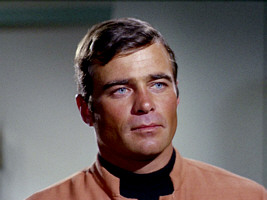
 Zefram Cochrane in TOS: "Metamorphosis"
Zefram Cochrane in TOS: "Metamorphosis"